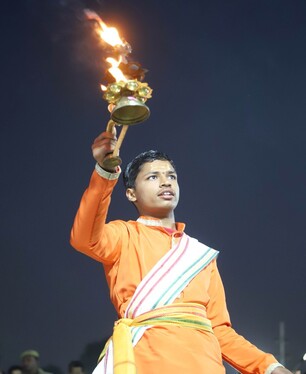
Aarti
Aarti In India, since ancient times, various forms of nature like rivers, mountains, and trees have been deemed Gods. In this course, continually flowing rivers served as a lifeline and are given immense importance. In simpler words, human existence demonstrates their gratitude towards rivers through Aartis on the riverbanks in which people participate to show their devotion towards the rivers. At places, these numbers are in hundreds, in others, they may reach several thousand and on special days the participants for these rituals gather in lakhs. Likewise, in Tirathraj Prayagraj, Aartis’ are performed on the banks of Ganga, Yamuna and at Sangam with great admiration, deep-rooted honor and devotion. In Prayagraj, Prayagraj Mela Authority and various other communities make grand arrangements for these Aartis. Lakhs of devotees take part on these occasions on special festive days. The Aartis are performed in the mornings and evenings, in which Batuks (priests), normally 5 to 7 in number, chant hymns with great fervor, holding meticulously designed lamps and worship the Ganga, the Yamuna and the Sangam with utmost devotion. The lamps held by the batuks represent the importance of panchtatva. On one hand, flames of the lamps signify bowing to the waters of the sacred rivers and on the other, the holy fumes emanating from the lamps appear to play the mystic of heaven on earth.
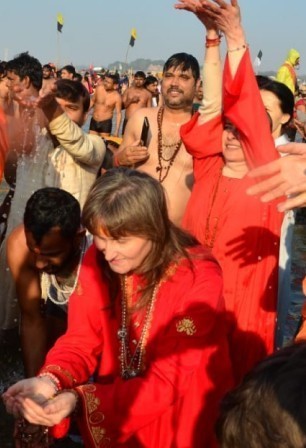
Snan
Prayagraj Kumbh comprises of many rituals including bathing ritual, which by far is the most significant rituals performed at Kumbh. Millions of pilgrims take part in the Kumbh bathing ritual at the Triveni Sangam. Performing this sacred ritual is in accordance with the belief that by submerging oneself in the holy waters, one is purged of all their sins, release themselves and their ancestors from the cycle of rebirth and ultimate attainment of Moksha. Along with the bathing ritual, the pilgrims also worship on the banks of the holy river and participate in discourses from various sadhus and saints. Although taking the dip in the sacred waters on all days of Prayagraj Kumbh beginning from Makar Sankranti (first day of the month of Magh, when the Sun enters Capricorn) is considered holy, yet there are some specific auspicious bathing dates. There are magnificent processions of saints and their disciples, and members of various Akharas (religious orders) take part in the ritual of Shahi Snan also known as ‘Rajyogi Snan’ at the start of Kumbh. Shahi Snan is the central highlight of Kumbh Mela and the most important part of the celebration. Only after the Shahi Snan people are allowed to take the holy bath, in the belief that the people will get the added advantage of the essence of holy deeds and thoughts of the holy saints by taking the holy dip after them.
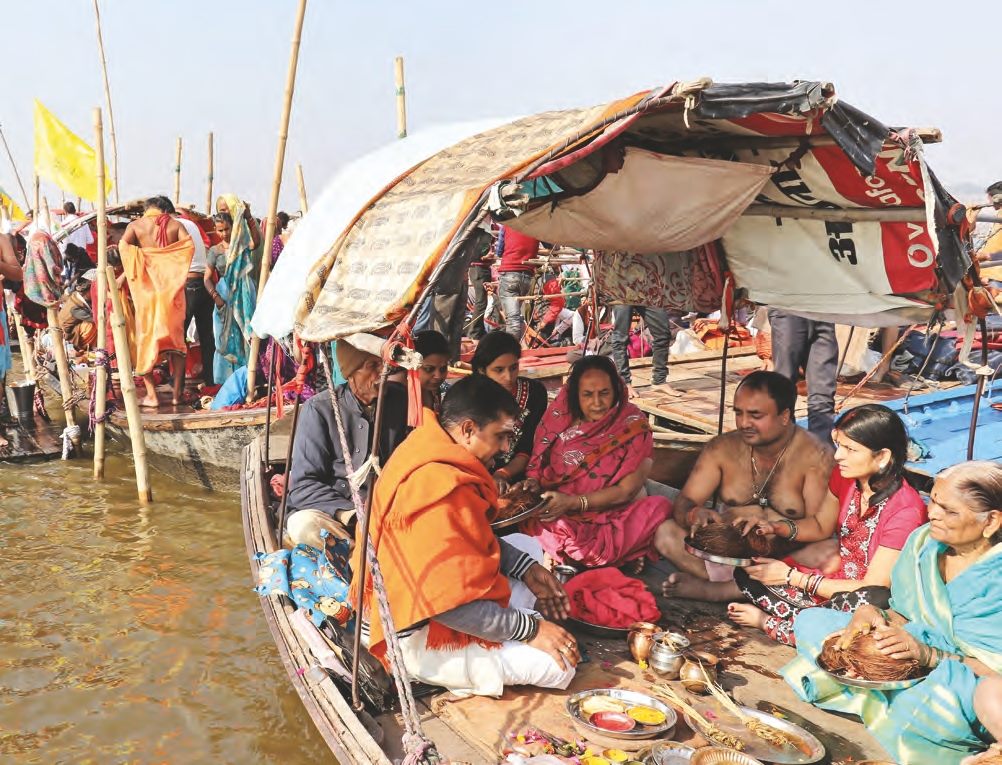
Kalpavas
Kalpavas, at the sacred confluence at Prayagraj during Maha Kumbh holds a special significance. According to ‘Brahma Purana’ and ‘Padma Purana’, the period of Kalpavas is from Ekadashi of the full moon in the Paush month up to ‘Maghi Ekadashi’. Maharishi Dattatreya outlines the ritual of Kalpavas in detail in the ‘Padma Purana’. According to the scripture, a Kalpavasi has to observe the 21 rules through mind, speech, and action. These rules are as follows:
- ✔True speech, i.e. (Abstinence from untruthfulness)
- ✔Non-violence
- ✔Mitigation of senses
- ✔Feeling benevolence for all living beings
- ✔Observance of celibacy
- ✔Renunciation of all indulgence
- ✔Rising before sunrise
- ✔Observance of ‘Trikal Sandhya’
- ✔‘Pind Daan’ of ancestors
- ✔Donate as per capacity
- ✔Afferent Jaap
- ✔Satsang
- ✔ class="tick"Shetra Sanyas (Non-violation of reserved space)
- ✔Renunciation from criticism
- ✔Offer services to ascetics and saints
- ✔Offer services to ascetics and saints
- ✔Japa
- ✔Sankirtan
- ✔Meals are to be taken only once a day
- ✔Sleeping on the ground and
- ✔Denouncing Gangodak-Agni.
‘Brahmacharya’ (The practice of celibacy)
‘Brahmacharya’ means living as ‘Bramha’, meaning evolving oneself into being the Bramha. In common parlance, renunciation of desires is ‘brahmacharya’ like luxury and substance indulgence, usage of oil-rich foods and sexual desire are the main elements for compliance to Brahmacharya.
Fasting (Vrat)
Fasting is the most important part of Kalpavas. During Kumbh special significance is given on fasting on specific days. Vrat may be divided into two categories, namely Nitya and Kamya. ‘Nitya’ Vrat signifies the fasting observed for the love of the divine, without any ambition. This inspires spiritual upliftment. Whereas, ‘Kamya’ Vrat is for procurement of any desired result.
Absolute observance of all ten aspects of dharma is necessary during the practice of fasting. Manu has described these ten dharmas to be:
Patience, Forgiveness, Selflessness, Not to steal, Physical purity, Control of senses, Wisdom, Knowledge, Speaking the truth and Non-violence
As denoted in the shloka:
‘Dhrutih kshama damoasteym shauchmindriynigrahDhivridha satyamkrodhi dashank dharmlakshanam’
Praying to Gods (Dev Pujan)
It is believed that during the Kumbh Mela the Gods visit the banks of Sangam and meditiating in their honor with complete devotion brings well-being. The devotion of the worshipper is paramount in Dev Pujan because, if the devotee is not completely immersed in the ceremony, then the pujan will not be fruitful.
The practice of Daan
Daan during Kumbh holds great significance. Here, both the donator and the receiver of alms are benefitted. Therefore, donation during Kumbh is considered greater than relinquishment. Gau-daan (donation of cow), Vastra Daan (donating of clothes), Dravya Daan (donating of money), Swarn Daan (donation of gold) has immense significance. Samrat Harshavardhan used to donate all his possessions every twelve years during Kumbh.
Satsang
Literal meaning of Satsang is to be in the company of truth. During Kumbh, the devotees should stay in close connection with the saints and intellectuals, should listen to their discourses, and offer them services. In order to liberate oneself from the feeling of selfishness and to inculcate equality to proceed on the path of attaining higher self.
Shraadh and oblation (Tarpan)
Shraadh means offering of Pinda with complete devotion that can only be performed by a priest. There are specialized priests available at Prayagraj only for this purpose as they have the genealogy of the devotee performing the shraadh. However, the Tarpan ritual may be performed by anyone while chanting the specific mantras.
Veeni Daan
In Prayagraj, ‘Veeni Daan’ holds a great significance in the Kumbh Mela. This ritual is performed by shaving one’s hair completely and leaving just the ‘Shikha’ (top knot) and offering it to the Ganga. It is believed that sin resides at the base of hair, and the Sangam, during Kumbh is the best place to absolve one from all their sins. It is believed that a Kalpvasi must do veni daan in Prayagraj during the Kumbh Mela.
Moreover, a Kalpvasi is supposed to wear only clean silk or woolen, white or yellow clothes. It is believed that leading this kind of life cleanses the body and soul.
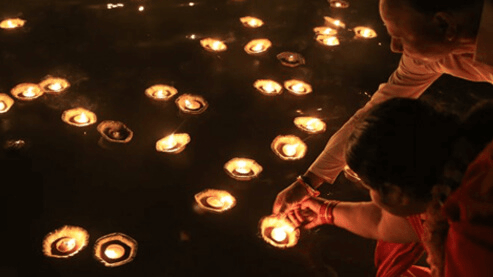
Deep Daan
At Triveni Sangam, numerous sparkling oil lamps fill the innermost conscience of the devotees with a heavenly feeling. Thousands of lighted Diyas (lamps) spread the light of spirituality across the environment in such a manner that the waves of religious fervour and devotion affect even the most atheist of people. The verbal meaning of ‘Deep Daan’ is the offering of lighted earthen lamps at specific places such as river banks, near temples, religious trees, in forests, or at any other sacred location. Devotees offer lighted earthen lamps (Deepak) in a specific month, at specific places and on specific occasions. For example, in the month of Kartik, Deep daan is done near the sacred Tulsi plant. On festivals like ‘Ganga Dussehra’, ‘Dev Deepavali’ ‘Magha Mela’, or ‘Kumbh Mela’, devotees make a vessel from leaves on which a lamp made of wheat flour filled with oil along with a cotton strand is lighted and floated on water as an offering of gratitude towards the river. Deep daan is also offered in thousands of numbers by boats by some devotees depending on their devotion, ability and commitment. Floating lighted Diyas on flowing water seem like twinkling stars reflecting divine brilliance in the Ganga. During Kumbh Mela in Prayagraj, this presents a mesmerising scene.
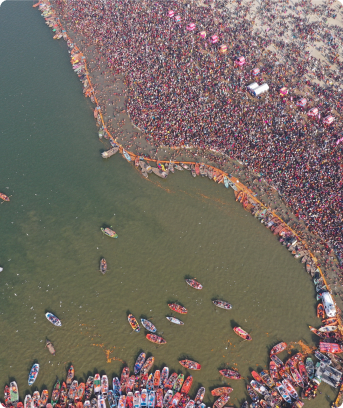
Triveni Sangam
Triveni Sangam is the confluence of the Ganga, the Yamuna and the mystical Saraswati. The Saraswati River is said to be the invisible river that surfaces only during Kumbh with the sacred chanting of hymns and elucidations representing knowledge. Sangam is said to be the basis of the congregation of millions of Pilgrims. In Mahabharata, it is stated that around sixty crore ten thousand pilgrimages are found in Prayagraj, and sangam is considered to be the base of most of the sixty crore pilgrimages. As per mythology, the pilgrimages are said to be brought to Sangam by the rivers themselves and that any spot where the holy water of these rivers reach is in itself a pilgrimage destination. Sangam has seen pilgrims and sages worshipping at the banks of the holy river since time immemorial. Millions of pilgrims visiting the Sangam during Maha Kumbh, Kumbh, and Ardha Kumbh are living proof of the spirit of Sangam. Various texts have defined Sangam, among which Bramha Purana refers to achieving the benefits of Ashvamedha Yajna by bathing at Sangam and Matsya Purana refers to achieving the benefits of the combined worship of ten thousand pilgrims. Skanda Purana has detailed the benefits of the various Snans (holy baths) during the holy months of January to March. These include Maghi Purnima, Basant Panchami, Mauni Amavasya, and Makar Sankranti.
Prayagraj Panchkoshi Parikrama
The changing times have had an impact on the course and the nature of the Kumbh festival. The rituals of “Parikrama” (circumambulation) have had a direct impact of such changes. Today, the ritual that has been an integral part of “Kumbh” since time immemorial has mostly lost its existence. In order to revive this historical ritual of utmost significance, the Shri Akhada Parishad and Mela Authority have re-mapped the “Parikrama” path and further plans to develop the temples that appear along this path. The goal here is to re-establish a historical ritual while providing an opportunity to the new generation to acquaint themselves with the rich history of this event of cultural, religious and spiritual significance. “Dwadash Madhav” temples and other significant temples that appear en route of “Prayagraj Panchkoshi Parikrama".
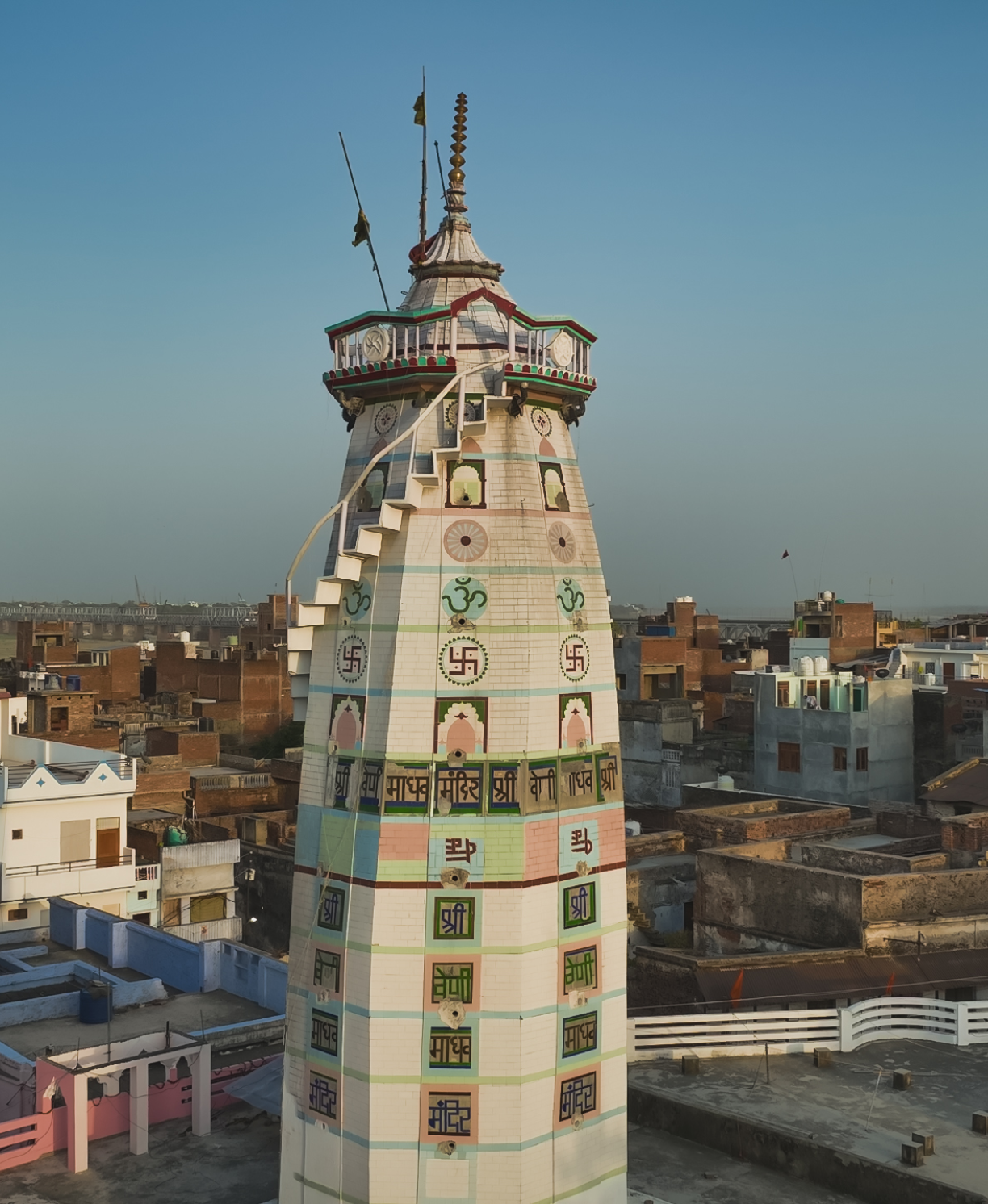
Shri Madhava Temples
1. Shri Adiveni Madhav
It is believed that Shri Adiveni Sangam has vanished in Triveni since it has no physical existence and therefore the entire Triveni is considered as the shrine.
2. Shri Asi Madhav
It is said that Shri Asi Madhav has their place in the Nagvasuki temple of Daraganj. It is believed that Shri Asi Madhav along with Lord Shiva had allowed the Naga sadhus to reside here. The statue of Shri Asi Madhav ji has been enshrined in the main temple.
3. Shri Sankashtahar Madhav
This temple is situated around 200 meters away from the bank of Ganga at Pratishthanpuri (Jhunsi), opposite to the ashram of Shri Prabhudatt ji Brahmachari. It is believed that Shri Brahmachari ji used to meditate under the ancient banyan tree of the temple. This ancient temple was in a broken-down state and the idol of Shri Madhav ji was also fragmented but now a new temple has been constructed at the same place and a new idol of Shri Madhav ji has been enshrined in the temple.
4. Shri Shankh Madhav
It is located at Munshi Bageecha near Chhatnagghat, east of Sangam. One can find the ashram of Maharshi Sadafaldev on this location even today. Some parts of the temple have been renovated. The idol of Shri Madhav ji has been enshrined in the compound of the temple. The temple is based on the Aryan style of architecture.
5. Shri Chakra Madhav
The temple was constructed in the agneya direction (Agni Kon) around fifty years ago in the Arail region of Chak Beniram.
6. Shri Adi Madhav
Shri Adi Madhavji resides in a temple near Arail ghat next to Shri Rameshwar Mahadev temple. The temple is an exquisite model of beautiful traditional Aryan architecture.
7. Shri Gada Madhav
It is said that Shri Gada Madhav ji resides towards the south of Shri Chakra Madhav. The idol of Shri Gada Madhav ji is currently enshrined in a newly constructed building near Chheoki Junction. Now, only the holy feet relics of the ancient idol whose height is approximately 15 inches remain enshrined in a ten-meter long corridor of the temple. The folklores mention a lake on this site in historic times which is believed to have been filled and subsequently occupied. On the south of this place is the boundary of holy Prajapati’s region. People believe that in past sages stayed here as receiving donations was prohibited at the confluence of holy river Ganga and Yamuna.
8. Shri Padma Madhav
The archaeological evidence collected from the location of Shri Padma Madhav indicate the original location to be in Veekar, situated towards the west of Naini. A Shiva temple located on top of an island in the midst of river Yamuna at Veekar Devariya is proclaimed as the abode of Shri Padma Madhav ji. The temple is known as Sujavan Dev and is only accessible by boat.
9. Shri Manohar Madhav
The temple of Shri Baba Darevarnath situated at Kamla Nehru Marg is believed to be the abode of Shri Manohar Madhav Ji. It is said that Kuberji himself worshipped Madhav ji at this location. The site also used to have an ashram of Kuberji in the past.
10. Shri Bindu Madhav
This area now located in the cantonment area. At the Draupadi ghat of this region, the idol of Shri Bindu Madhav Ji was established. Today one can find the idol of the deity at Draupadi ji temple itself.
11. Shri Veni Madhav
Shri Veni Madhav ji is located in a two-storey building at Daraganj in Nirala Marg. This is the most famous Madhav temple among all.
12. Shri Anant Madhav
It is said that Shri Anant Madhavji is situated in Devagirva, which is 4 km away from Khuldabad, west of Prayagraj. This temple and its nearby area fall under the army cantonment area Apart from these twelve Madhvas, one more Madhva in Prayagraj has been illustrated in various texts. This Madhavas is said to be located at the roots of Akshayavata.
Akshayavata | Patalpuri Mandir:
The indestructible nature of Akshayavata in pralaykaal (Destruction of Universe) has been mentioned in several religious text and Puranas. The same Akshayavata is the part of Patalpuri temple situated in the basement of Prayagraj fort built by Akbar. Some of the branches of the Akshayavata are secured in the adjacent part of Patalpuri temple.
Padila Mahadeo ji
At a distance of 15 km from Prayagraj on Phaphamau-Varanasi road, there is a famous ancient temple of Padilla Mahadeo. Baiju temple is also located on the same premises. Baiju was a famous devotee of Lord Shiva. It is said that during Agyatvas, Pandavas had established the Shivalingam at this temple. Kanwarias and devotees of Shiva visit the temple in large number in the Shravan month.
Koti Tirtha shiva Kuti ji
All through the month of Shravan, a Mela is organised at the dham of Tirtheswar Bhagwan Shiva. There is special importance accorded to visiting and bathing in this Tirtha. It is considered that the donations and offerings made on behalf of the lineages are highly fruitful. It is also believed that Bhagwan Ram worshipped at this place in order to release himself from the effects of Brahamhatya by making thousands earthen shivalingams as per the directives of Maharshi Bhardwaj.
Shaktipeetha
Shaktipeethas of Prayagraj are listed below along with their significance:
Maa Lalita Devi
Maa Lalita Devi temple is situated at Meerapur, and is a part of the 51 Shaktipeethas of Goddes Sati. About 50 years Prabhu Dutta Brahamchari ji constructed a small temple here, which later, developed in to the present temple.
Kalyani Devi
Kalyani Devi considered as the favoured deity of Maharshi Bhardwaj. The current structure is about 1500 years old. It is said Maharshi Yagya Valka had established an idol measuring 32 fingerlength of Maa Kalyani Devi at this temple. Devotees have great faith in this temple.
Alopshankari Devi
Alopshankari Devi mandir situated in Alopibagh is under the management of Mahanirvani panchayat Akhara. It is one of the Shakti Peethas of this country. Fingers of Devi Sati had fallen here and, there is in idol of Devi. There is a kund in the middle of rectangular plateform in which water is filled. A swing (jhoola) hanging from the roof of the temple is placed just above kund. Both the jhoola and the kund are worshipped.
Bara sthan of Tulsi Das ji
At the southern gate of Daraganj in mela area, there is big location dedicated to Tulsi Das ji. Akbar tried his best to destroy this siddha place, which lied in course of a dam construction site. Followers of all four Vaishnava sects go for the sangam snan through this place holding the victory flag of Hanuman ji, known as Nisham. These flags are kept safeguarded for next kumbha.
Bade Hanuman ji
Below the triveni bandh on sangam river front, there is temple of bade Hanuman ji. Only lying idol of Hanuman ji in the country is in this temple. feets of Hanuman ji is towards south and below a feet, idol of deity of patal kunda is found and below second feet Abhiravan is pressed. Under right arm Makardhwaj and the left Shri Ram and Luxman may be seen. Daily large number of people visit this temple. It was constructed by siddha sant bhagambari baba on Ganga bank.
Shankar Viman Mandapam
Swami Chandra Shekhar Saraswati, Shankaracharya of Kanchi Kam Koti Peetham, established this temple on the Ganga bank of Triveni Bandh this temple based on 15 pillars. There are more that 300 idols in this temple, based on south Indian architecture, designers prepared this structure with untiring labour for many years. Sahastra Mukhi shivling is installed on the third floor of three-storied temple.
Mankameshwar Mandir
Being a temple in the basement of Prayagraj fort it is opened only in magh month for visiting. There are more than 40 idol of Ganesha, Guru Gorakhnath, Narsingham, Shivlingam and Dharmraja.

